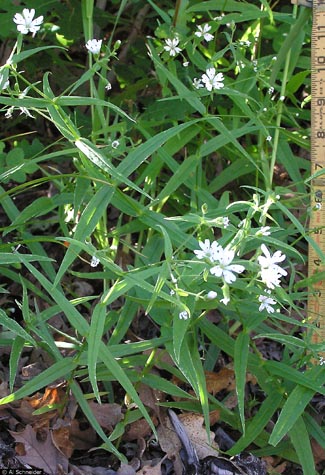Jame's Chickweed

Common Name(s):
Jame's Chickweed
James Stitchwort
Tuber Starwort
Sticky Starwort
Scientific Name:
Pseudostellaria jamesiana (Torr.) W.A.Weber & R.L. Hartman
Scientific Name Synonyms:
Stellaria jamesiana Torr.
Arenaria jamesiana (Torr.) Shinners
Alsine jamesiana (Torr.) Heller
Symbol:
PSJA2
Description:
Life Span: Perennial
Origin: Native
Growth Characteristics: James’ Chickweed is a narrowly erect forb with leaves standing out at stiff right angles and leaf tips gently curved downward. It grows from 4 to 24 inches tall. Flowering occurs May-July.
Flowers/Inflorescence: Several to many flowers contained in bunches (cymes) found at stem ends and in leaf axils. The small, bright white flowers have 5 petals, which are notched 1/5 to 1/3 of their length and are roughly triangular in outline. The petals are about twice as long as the sepals and have gland-tipped hairs. The flower contains 10 stamens, and a single pistil with 3 style branches.
Fruits/Seeds: Fruit is shorter than the sepal and opens by 3 valves.
Leaves: Leaves are sessile at the base and measure up to 5 inches long. The blades are covered with gland-tipped hairs and are narrow, long, opposite, and ridged.
Stems: Weak, ascending to erect stems, up to 20 inches tall. They are 4-sided, glabrous below but covered with gland-tipped hairs. Nodes are swollen.
Roots: Thick, fleshy roots – where the name “Tuber” sandwort came from. It also has slender rhizomes.
Ecological Adaptions:
James’ Chickweed is usually found in moist, shaded areas, being common along stream, among shrubs, and especially among Aspen. It can also be found on open, rocky slopes. It occurs most often in clusters in scattered patches. In the Intermountain West, it occurs from about 4500 to 10000 feet.
Soils: Most likely to grow on sandy or gravelly loams.
Associated Species: Quaking Aspen
Uses and Management:
The flowers are cropped by grazing animals. The starchy, tuberous rootstocks are edible, tasting somewhat like sweet potatoes. They were an important source of food among Native Americans.

